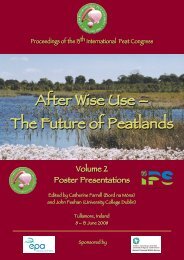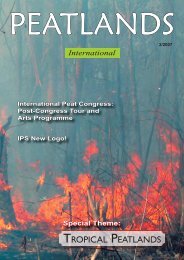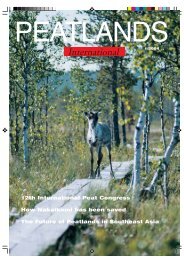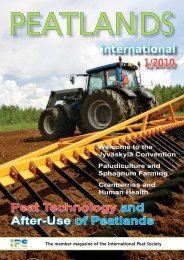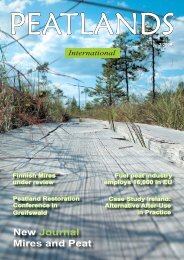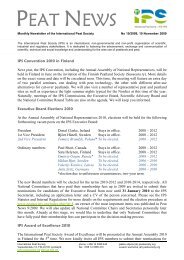peatlands 1 taitto.indd - International Peat Society
peatlands 1 taitto.indd - International Peat Society
peatlands 1 taitto.indd - International Peat Society
Create successful ePaper yourself
Turn your PDF publications into a flip-book with our unique Google optimized e-Paper software.
A lot of under 300-year-old peat layers<br />
in Finland Text: Markku Mäkilä<br />
Markku Mäkilä from the<br />
Geological Survey of Finland<br />
analyzes the carbon storage<br />
abilities of Finnish mires<br />
according to their age, type<br />
and location.<br />
Geological peatland covers an area<br />
of 5.1 million ha in Finland, having<br />
a mean depth of 1.4 m. The Finnish<br />
national peat reserves total 69.3 billion<br />
m 3 in situ, while the carbon storage of<br />
Finnish mires is 3.2 billion t (627 t per<br />
hectare). The original peatland area<br />
covered ca. 10 million hectares.<br />
The long-term peat increment of<br />
Finnish mires has been calculated on<br />
the basis of 520 dated peat columns.<br />
The calibrated radiocarbon ages<br />
correspond to the present time, as<br />
50 years were added to them. The<br />
long-term peat increment in Finnish<br />
mires varies considerably, depending<br />
on many factors. For example, the rate<br />
of increment is higher in geologically<br />
young mires than in old ones (Fig. 1),<br />
higher in southern and western than<br />
in eastern and northern Finland, and<br />
higher in ombrotrophic bogs of southern<br />
Finland (Sphagnum area) than in<br />
minerotrophic mires (sedge area) of<br />
northern Finland (Fig. 1).<br />
The highest recorded rates are 2-3<br />
mm yr -1 in young coastal bogs and the<br />
lowest, under 0.1 mm yr -1 , in the uplands<br />
of northern and eastern Finland,<br />
where the bottom soil topography is<br />
sloping. The average peat increment<br />
rate is 0.32 mm yr -1 . The rate in areas<br />
of peat deeper than 2 metres is 0.4<br />
mm yr -1 , when northern aapa and palsa<br />
areas are excluded.<br />
The vertical peat increment rate<br />
was determined from 39 dated peat<br />
columns mainly representing the thickest<br />
peat layers of mires. Several datings<br />
were performed from separate levels<br />
in each column. The rate has varied<br />
greatly during the last 10 000 years<br />
(Fig. 2). Variations in peat increment<br />
rates can mainly be explained by the<br />
changes in vegetation composition and<br />
decomposition rates due to natural<br />
mire succession and variations in local<br />
conditions, especially moisture and<br />
nutrient conditions. However, the role<br />
of the climate cannot be ignored. Usually,<br />
about 5-20% of the plant biomass<br />
production is deposited as peat. Most<br />
of the biomass decays in the oxic peat<br />
layer at the surface and returns to the<br />
atmosphere as carbon dioxide (CO 2) .<br />
The proportion of the carbon<br />
store of mires contained in the surface<br />
peat layer (age 50-430 years, average<br />
250 years) was<br />
examined in 25<br />
peat columns of<br />
known age, dry<br />
bulk density and<br />
carbon content.<br />
This proportion<br />
was found to<br />
vary considerably<br />
(2-37%),<br />
approximately<br />
corresponding to<br />
the proportion of<br />
virgin peat but not<br />
the proportion of<br />
the energy content<br />
in the surface<br />
layer. However,<br />
due to the natural<br />
conditions, especially<br />
the moisture<br />
and nutrient<br />
conditions, areal<br />
differences were<br />
substantial and the<br />
proportion differed<br />
greatly even<br />
between adjacent<br />
mires. In addition<br />
to the age of the<br />
surface peat layer,<br />
the carbon store<br />
also depends on<br />
many other fac-<br />
tors such as the thickness of both the<br />
surface (0.1-1.0 m) and the total peat<br />
layer (0.5-7.8 m), and the age (710-10<br />
440 years) and carbon store of the<br />
total peat layer (180-2790 t ha -1 ).<br />
The highest proportions of carbon<br />
in the surface peat layer (>20%) were<br />
found in quite young mires under 1000<br />
years old in the coastal bogs of the<br />
highest uplift area. For example, in this<br />
type of bog the carbon content of surface<br />
peat layers aged 160 years was 114<br />
t ha -1 on average. The carbon accumulation<br />
(g m -2 yr -1 ) of this type of young<br />
bog can be compared to the annual<br />
carbon accumulation of young birch<br />
Fig. 1. The variability of long-term peat increment rates in various<br />
parts of Finland.<br />
7



